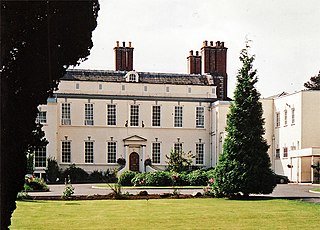
Baron Airedale, of Gledhow in the West Riding of the County of York, was a title in the Peerage of the United Kingdom. It was created on 17 July 1907 for the Liberal politician Sir James Kitson, 1st Baronet, who had previously represented Colne Valley in the House of Commons and served as Lord Mayor of Leeds. Kitson had already been created a Baronet, of Gledhow in the West Riding of the County of York, in the Baronetage of the United Kingdom 1886. Variations of the name Kitson included Kittson whose family crest incorporated a demi-unicorn. This unicorn is evident in the Airedale crest atop the arms granted to James Kitson, 1st Baron Airedale in 1907. Both the title (Barony) and Baronetcy became extinct on the death of his grandson, the fourth Baron, in 1996.

Oliver James Vandeleur Kitson, 4th Baron Airedale, "an able and devoted" politician, member of the Liberal Party and then of the Liberal Democrats, was a British peer.

Captain Roland Dudley Kitson, 3rd Baron Airedale, businessman, was born in Leeds, son of Sir James Kitson, 1st Baron Airedale and his second wife, Mary Laura, daughter of Edward Fisher Smith. Roland's elder half-brother was Albert Kitson, 2nd Baron Airedale.

James Kitson, 1st Baron Airedale, PC, DSc, was an industrialist, locomotive builder, Liberal Party politician and a Member of Parliament for the Holme Valley. He was known as Sir James Kitson from 1886, until he was elevated to the peerage in 1907. Lord Airedale was a prominent Unitarian in Leeds, Yorkshire.
General Lord Robert Manners was an English soldier and nobleman. He was a son of John Manners, 2nd Duke of Rutland and his second wife, Lucy Sherard.

Bramham Park is a Grade I listed 18th-century country house in Bramham, between Leeds and Wetherby, in West Yorkshire, England.

Chapel Allerton Hospital is located in the area of Chapel Allerton, Leeds, West Yorkshire, England and is operated by the Leeds Teaching Hospitals NHS Trust. The main entrance is on Chapeltown Road, with vehicle exits onto Harehills Lane and Newton Road.
Lord Cecil Reginald John Manners DL, was a British Conservative politician.

Ufford is a village and civil parish, now in the Peterborough unitary authority of the ceremonial county of Cambridgeshire, England. It was historically part of the Soke of Peterborough, which was associated with Northamptonshire but had its own County Council from 1888 until 1974. For electoral purposes it forms part of Barnack ward and is in the North West Cambridgeshire constituency.

Tyttenhanger House is a 17th-century country mansion, now converted into commercial offices, at Tyttenhanger, near St Albans, Hertfordshire. It is a Grade I listed building.

Milton Hall near Peterborough, is the largest private house in Cambridgeshire, England. As part of the Soke of Peterborough, it was formerly part of Northamptonshire. It dates from 1594, being the historical home of the Fitzwilliam family, and is situated in an extensive park in which some original oak trees from an earlier Tudor deer park survive. The house is a Grade I listed building; the garden is Grade II*.

Stapleford Park is a Grade I listed country house in Stapleford, near Melton Mowbray in Leicestershire, England, which is now used as a hotel. It was originally the seat of the Sherard and Tamblyn families, later the Earls of Harborough and, from 1894, of the Gretton family, who would become the Barons Gretton.

Kinlet Hall is an 18th-century, 33,609 square feet (3,122 m2) English country house at Kinlet, Shropshire, England, now occupied by an independent day and residential school. It is a Grade I listed building and its design was inspired by Villa Pisani, Montagnana.

Haughton Hall is an early 18th-century country house situated at Haughton Lane, Shifnal, Shropshire, England now converted for use as a hotel. It is a Grade II* listed building.

Goadby Hall is a privately owned 17th-century country house located in Towns Lane, Goadby Marwood, Leicestershire. It is an historical Grade II* listed building.

Damhouse or Astley Hall is a Grade II* Listed building in Astley, Greater Manchester, England. It has served as a manor house, sanatorium, and, since restoration in 2000, houses offices, a clinic, nursery and tearooms.

Gaddesby Hall is an 18th-century brick-built house in the village of Gaddesby, Leicestershire. It was built in the late 1740s as a three-storey house with additions of 1868. It is a Grade II listed building.

Astley Hall is a country house in Astley near Stourport-on-Severn, Worcestershire, England. The hall was the home of Prime Minister Stanley Baldwin from 1902 until his death there in 1947. It is now a nursing home.

Gledhow Hall is an English country house in Gledhow, Leeds, West Yorkshire. A house, built in the 17th-century by John Thwaites, was remodelled for a new owner by the Yorkshire architect John Carr. It is a Grade II* listed building and has been converted into flats.

Heath Hall, Heath, Wakefield, West Yorkshire is a country house dating from 1709. Originally called Eshald House, the estate was purchased by John Smyth whose nephew engaged John Carr of York to reconstruct the house between 1754 and 1780. In the 19th century, the house was remodelled by Anthony Salvin. Heath Hall is a Grade I listed building.




















